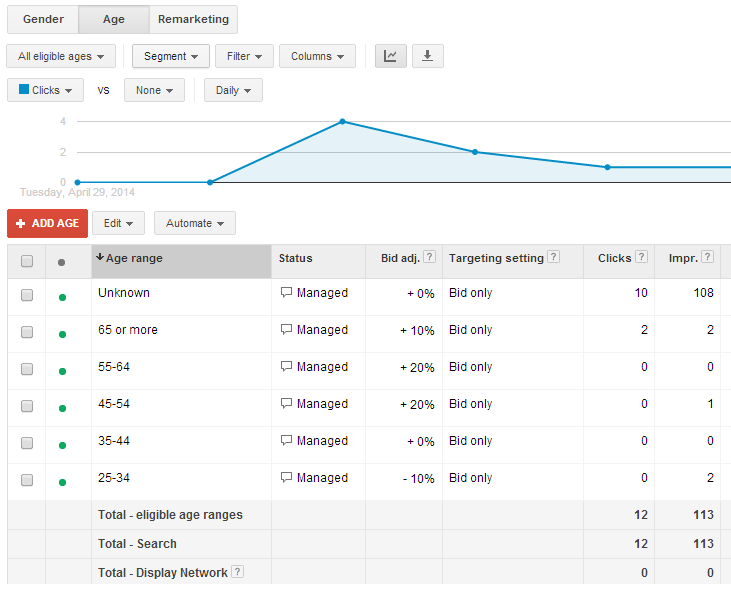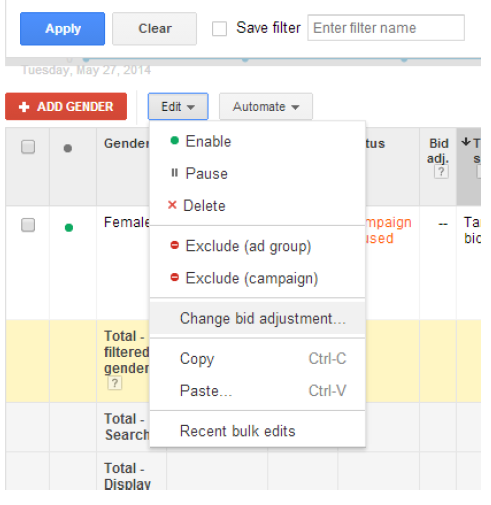With over 200 Adwords updates in 2014, Google shows no sign of slowing down. The most recent and arguably the most exciting update comes in the form of another acronym: DFSAs (Demographics For Search Ads) – not to be confused with DSAs (Dynamic Search Ads).
This new feature is compatible with both new and returning visitors and allows you to reach high value demographics based on the performance of certain ages and genders. What makes this feature so powerful is the ability to target top converting audience segments with a custom bidding and creative strategy. You can also exclude certain demographics which may be deemed irrelevant to those campaigns – this in turn will help eliminate unqualified traffic and reduce wasted spend, resulting in increased ROI and reduced CPA (your clients will love you!).
Let’s take a look at how to set up and approach your DFSAs to ‘make every click matter’…
Which campaigns will benefit?
DFSAs work best with keywords that are outside of premium positions. Campaigns with an average position of 2.0 are going to be your ideal candidates as the opportunity is far greater to gain incremental clicks from an improved positional advantage. Campaigns with an average position in the 1.0 and 1.9 range could also benefit from DFSAs (so don’t disregard these!).
How to analyse historic performance
Reporting for all managed demographics will appear in the ‘audiences’ tab. This can be found at the AdGroup-Demographic level with a total row for all managed demographics. This is also the section where you will be able to apply bid adjustments to both gender and age.
Take a strategic approach to DFSAs
Existing keywords
It’s important to up-weight your bids when your target audience searches for your existing keywords. There might be certain instances where some of your brand-generic keywords have too low of an ROI to be in premium positions. Go through to the audiences tab and up-weight bids for your highest converting demographics.
Layer up
Standard RLSAs have been a real game changer for bidding on generic keywords that have historically converted at very low rates. Now, with DFSAs layered on top of RLSAs, marketers are able to supercharge their keyword strategy by entering auctions and paying for clicks from users with the highest purchase intent.
Look inside your existing RLSA campaigns and find out exactly which demographics have the highest conversion rates. Once you have this information, duplicate your campaign so that you are exclusively targeting these demographics and up-weighting bids based on performance.
Go beyond direct response with tailored ads
Paid search marketers can now go far beyond the classic ‘buy, buy, buy’ approach. We can now really start to hone in on individual characteristics of the buyer to deliver personalised messaging.
If you are a little apprehensive about the ‘right’ way to deliver your creative strategy, then a persona document is a great place to start. This will not only guide your creative testing with DFSAs but will also help drive other parts of your online and offline strategy, be it content creation for SEO, or online branding exercises such as video advertising.
Here are a few points to think about when creating your demographic-based ad copy:
- Overall perceptions of your brand
- The relationship users have with your brand
- Key interests of your target audience
- Top reasons why they buy your brand
- Top reason why they don’t buy your brand
Landing pages
In line with your creative strategy, use your historic demographic performance to help guide changes to your landing pages.
Take a life insurance company, for example. Each one will have pricing structures which differ according to age and gender. Splitting your campaigns out in this same way will allow you to better capitalize on these demographics and deliver highly-targeted messaging from the ad copy through to the landing page. The combination of these two components will drastically increase conversion rates and lower your CPA.
Exclusions
Make sure you stop bidding on poorly performing audiences outside of your target demographic. Your clicks will now be even more qualified and convert at a higher rate; so if you want to target men looking for a snazzy haircut this Christmas, then exclude women!
NB: In all instances, it is crucial to ensure that you continue to show ads to the “unknown” segment, as this represents on average 55% of the available traffic.
Image of account showing gender exclusion
How much traffic can you expect from up-weighted bids?
If you’re interested in seeing how much extra traffic you are expected to receive from increasing bids, then navigate over to the ‘opportunities’ tab and take advantage of AdWords’ ‘campaign simulator’. Take this tool with a pinch of salt as it is by no means perfect. It will, however, give you a good indication of the incremental clicks that you can expect if you change your bids.
Summary
DFSAs are yet another powerful weapon that can be placed in your paid search arsenal. Along with RLSAs, they will change the way we approach audience targeting, as well as our overall strategy to how we operate ‘search’. As the update is still in beta, we are still deepening our understanding of its true value and the full extent of its capabilities.
Watch this space….




